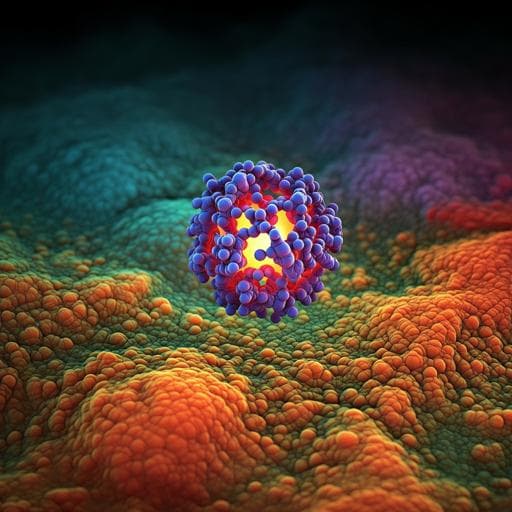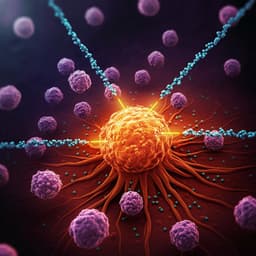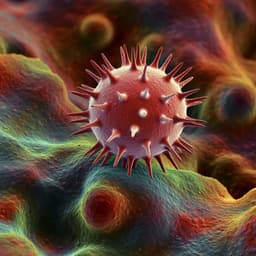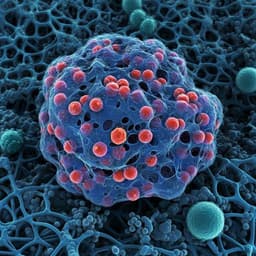
Medicine and Health
Ligand-switchable nanoparticles resembling viral surface for sequential drug delivery and improved oral insulin therapy
T. Yang, A. Wang, et al.
Discover how innovative ligand-switchable nanoparticles can revolutionize drug delivery! This research by Tiantian Yang and colleagues reveals how pH-responsive nanoparticles effectively navigate the intestinal barrier and target the liver, significantly improving glucose control in diabetic rats.
~3 min • Beginner • English
Introduction
The study addresses the challenge that multifunctional nanoparticles with multiple surface ligands often suffer from mutual interference (steric and electrostatic), reducing receptor binding and in vivo efficacy. The authors hypothesize that a ligand-switchable design, inspired by virus surface protein conformational changes, can sequentially display different functions along the oral delivery route to avoid interference. They design PLGA nanoparticles bearing a pH-responsive stretchable cell-penetrating peptide (Pep) and a galactose (Gal) hepatic-targeting ligand, enabling intestinal barrier traversal at mildly acidic pH and hepatocyte targeting at physiological pH. As a proof-of-concept, they aim to improve oral insulin therapy by enhancing intestinal absorption, restoring the portal-periphery insulin gradient, and promoting hepatic glucose utilization.
Literature Review
Prior strategies to mitigate ligand interference include optimizing ligand length, ratio, and density; using enzyme-responsive linkers to expose ligands at target sites; and employing pH-sensitive chain actuators (e.g., polyhistidine) to modulate ligand exposure. While these approaches improved targeting efficiency, fully realizing the multiple functions of diverse ligands remains difficult due to interference. Virus-like strategies that alter surface protein conformation in response to environmental cues inspire the current ligand-switchable design to sequentially display functions for barrier traversal and targeting.
Methodology
- Design and synthesis: A pH-triggered stretchable Pep, R8G5(HE)10, was synthesized and validated by ESI-MS and 1H NMR. Its pH-dependent conformation was characterized by circular dichroism (increase in β-sheet content from 11.9% at pH 6.8 to 26.5% at pH 7.4) and FRET using Edans/Dabcyl-labeled termini to confirm folding at physiological pH. Hemolytic assays established pH-activated membrane activity at pH <7.0.
- Polymer conjugates: Pep was conjugated to PLGA-Mal to yield PLGA-Pep (disappearance of maleimide peak at 6.8 ppm in 1H NMR). Gal was linked via PEG (1 kDa) to PLGA-COOH to form PLGA-PEG-Gal (PEG methylene signal at 3.6 ppm), enabling Gal exposure when Pep folds.
- Nanoparticle preparation: PLGA nanoparticles (PNPs) with various ligand decorations (PNP, Pep-PNP, Gal-PNP, CPP/Gal-PNP, Pep/Gal-PNP) were fabricated via double emulsion/solvent evaporation. Ligand modification rates for Pep and Gal were ~5%. Insulin was encapsulated as a model drug; entrapment efficiency 48.1%, loading capacity 7.9%.
- Physicochemical characterization: DLS assessed size and zeta potential across pH 3.0–8.0; cryo-TEM imaged morphology; AFM visualized ligand coronas under pH 6.8 vs 7.4 to confirm Pep length changes; stability tested in PBS, SGF, and SIF (4 h). In vitro insulin release and CD of released insulin assessed structural preservation.
- Mucus penetration: HT29-MTX-E12 mucus model evaluated penetration at pH 6.8 and 7.4.
- Cellular uptake and mechanisms: Caco-2 viability (MTT) and uptake of FITC-labeled formulations across pH 6.0–8.0; CPP/Gal-PNPs (non-switchable comparator) included. Endocytosis pathways assessed using low temperature and inhibitors (amiloride, chlorpromazine, filipin). Lysosomal colocalization and escape examined with LysoTracker.
- Transepithelial transport: Caco-2 Transwell model measured Papp, TEER changes, and nanoparticle integrity post-exocytosis via FITC/RITC co-encapsulation FRET and cryo-TEM. Retained Pep pH sensitivity after transcytosis verified with Edans/Dabcyl-labeled Pep in nanoparticles.
- Hepatocyte interaction: LO2 cells (ASGPR-positive) used to test Gal-dependent binding at pH 7.4; competition with free Gal; immunofluorescent colocalization with ASGPR. Insulin signaling assessed by time-course and pulse-chase p-AKT (Ser473) Western blots.
- In vivo imaging and distribution: Two-photon microscopy (TPM) and CLSM of intestinal loops assessed absorption at pH 6.8 vs 7.4; IVIS quantified organ biodistribution at 4 h post-oral administration. Liver section immunofluorescence measured colocalization with ASGPR. In vivo ligand switching evaluated via FAM/TAMRA-labeled Pep FRET in intestine (2 h) and liver (4 h). Confocal laser endomicroscopy visualized real-time intestinal and hepatic accumulation.
- Pharmacodynamics and pharmacokinetics: Type I diabetic rats received insulin (s.c.) or oral formulations; blood glucose monitored; serum insulin quantified by ELISA to derive AUC, Tmax, relative bioavailability (F) and pharmacological availability (PA). Portal versus peripheral insulin levels measured to quantify hepatic insulin availability and portal-periphery gradient.
- Hepatic glycogen: Hepatic glycogen content quantified by ELISA and PAS staining in healthy and diabetic rats across treatment groups.
- Safety: Repeated high-dose oral administration (1000 mg/kg) for 7 days; body weight, serum ALT/AST, and H&E histology (intestine and liver) evaluated.
Key Findings
- Pep conformational switching: Pep theoretical length 10.85 nm (open, pH<7) vs 7.00–7.88 nm (closed, pH 7.4); β-sheet content increased from 11.9% (pH 6.8) to 26.5% (pH 7.4). FRET confirmed folding at pH 7.4; Pep displayed pH-dependent hemolysis (active <7.0; inactive at 7.4).
- Nanoparticle switching behavior: Pep-PNP diameter decreased by ~20 nm from pH 6.8 to 7.4; zeta potential switched from positive to negative (Pep-PNP and Pep/Gal-PNP), while PNPs stayed ~−35 mV. AFM showed Pep corona thickness decrease by ~8 nm (25.86 ± 2.54 nm to 17.08 ± 0.60 nm) when shifting to pH 7.4; PEG-Gal corona remained 21–23 nm across pH, confirming selective Pep folding and Gal exposure.
- Stability and release: Pep/Gal-PNPs stable in SGF/SIF (4 h); ~23% insulin released in 4 h; released insulin retained native-like structure by CD.
- Cellular uptake and transport: In Caco-2 cells, insulin uptake from Pep/Gal-PNPs was 2.6-fold higher at pH 6.8 vs 7.4 and ~4.7-fold higher than PNPs at pH 6.8; free insulin showed minimal uptake. Mechanistically, clathrin-mediated endocytosis predominated at pH 6.8 (chlorpromazine reduced uptake to 39.7% of control), while macropinocytosis contributed at pH 7.4 (amiloride reduced to 49.6%); filipin had negligible effect. Lysosomal colocalization was low for all groups, indicating escape. Pep/Gal-PNPs achieved highest Papp at pH 6.8: 9.62 ± 1.34 × 10^−6 cm s^−1, a 2.9-fold increase over pH 7.4; TEER unchanged, indicating transcellular transport. Nanoparticles remained intact after exocytosis (FRET, cryo-TEM) and retained Pep pH responsiveness.
- Hepatocyte targeting and signaling: At pH 7.4, Pep/Gal-PNPs bound LO2 hepatocytes via Gal-ASGPR interaction (competition by Gal reduced binding) and colocalized with ASGPR. Insulin delivered by Pep/Gal-PNPs activated p-AKT over time, reaching levels comparable to free insulin by 2 h; pulse-chase assays showed sustained p-AKT 4 h after nanoparticle removal, unlike free insulin.
- In vivo absorption and distribution: Pep/Gal-PNP absorption into intestinal villi was 3.6-fold higher at pH 6.8 than 7.4; CPP/Gal-PNPs showed no pH dependence. At 4 h post-oral dosing, liver homogenate fluorescence for Pep/Gal-PNPs was 1.66-fold higher than CPP/Gal-PNPs; of total absorbed nanoparticles, 71.9% ± 3.7% accumulated in liver and 12.5% ± 1.5% in kidney (CPP/Gal-PNP kidney 23.0% ± 4.0%). Liver IVIS showed predominant hepatic accumulation for Pep/Gal-PNPs. Liver section colocalization with ASGPR had R = 0.32 for Pep/Gal-PNPs vs 0.03 for CPP/Gal-PNPs (10.7-fold increase).
- In vivo ligand switching: FRET efficiency of FR-Pep/Gal-PNPs was low in intestine (~11.6%) and increased ~5-fold in liver, confirming Pep folding and Gal exposure in vivo.
- Pharmacodynamics and pharmacokinetics: In diabetic rats, Pep/Gal-PNPs produced sustained hypoglycemia with minimum BGL 23.2% of baseline at 8 h and maintained BGL in normal range for 7 h; PA = 10.1%. PK: Pep/Gal-PNPs (oral, 75 IU/kg) yielded AUC 210.6 ± 14.9 µIU·h·mL^−1, Tmax 4 h, relative bioavailability F = 7.7% vs s.c. insulin.
- Hepatic glucose utilization: Pep/Gal-PNPs induced the highest hepatic glycogen content: ~7.2-fold over diabetic control, 1.9-fold over s.c. insulin, and 2.7-fold over CPP/Gal-PNP, approaching levels in healthy rats. Portal insulin AUC was 4.1-fold higher than s.c. insulin; portal-to-peripheral insulin exposure increased ~4.2-fold, restoring an endogenous-like gradient. Hepatic insulin availability (Fr) exceeded peripheral bioavailability (19.9% vs ~7%).
- Safety: No adverse effects at 20× effective dose over 7 days; body weight unchanged; serum ALT/AST within normal ranges; no histological damage in intestine or liver.
Discussion
The ligand-switchable Pep/Gal-PNPs address the core problem of mutual interference among multiple surface ligands by using a virus-inspired pH-responsive peptide to sequentially display functions: Pep extends and activates at mildly acidic intestinal pH to enhance epithelial uptake and transcytosis, then folds at physiological pH to deshield Gal for selective hepatocyte targeting via ASGPR. This design improved intestinal absorption, maintained nanoparticle integrity through transport, and achieved focused liver deposition. Functionally, the system restored a physiological portal-periphery insulin gradient, enhanced hepatic insulin exposure, and promoted hepatic glycogen synthesis, thereby offering more stable glycemic control than subcutaneous insulin and non-switchable nanoparticle controls. The findings demonstrate that dynamic, environment-responsive ligand presentation can unlock the full potential of multifunctional nanocarriers and reduce off-target distribution inherent to non-switchable cell-penetrating designs. The approach avoids using virion components, potentially reducing immunogenicity risks while emulating beneficial viral surface dynamics.
Conclusion
This work introduces ligand-switchable PLGA nanoparticles that mimic viral surface conformational dynamics to sequentially optimize intestinal translocation and hepatocyte targeting. By combining a pH-responsive stretchable cell-penetrating peptide with a Gal ligand, the platform achieved enhanced oral insulin delivery, restored portal-dominant insulin exposure, and markedly increased hepatic glycogen storage in diabetic rats, resulting in sustained hypoglycemic control. The strategy provides a generalizable route to fully utilize multiple ligands on nanocarriers and could be applied to oral delivery of biomacromolecules and targeted therapies (e.g., antitumor drugs). Future work may explore translation to larger animal models, long-term efficacy and safety, optimization of ligand ratios and densities, and extension to other receptor–ligand pairs and therapeutic cargos.
Limitations
The article does not explicitly discuss limitations. While the design emulates viral surface dynamics without virion components, further studies will be needed to assess long-term safety, immunogenicity, and translatability to other species and therapeutic contexts.
Related Publications
Explore these studies to deepen your understanding of the subject.







